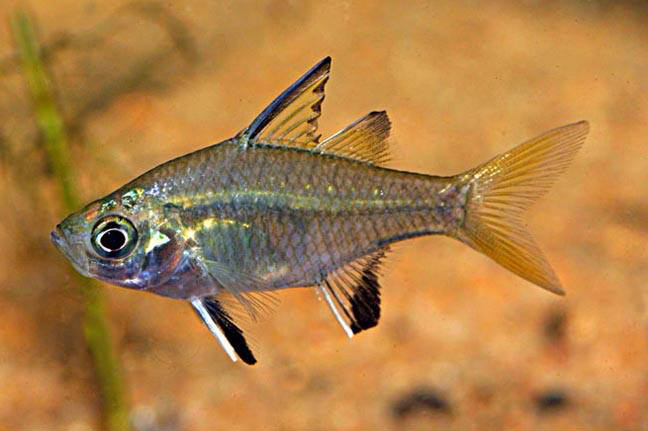Sailfin Glassfish, Ambassis agrammus Günther 1867

Sailfin Glassfish, Ambassis agrammus. Source: Dave Wilson / Aquagreen. License: All rights reserved
Sailfin Glassfish, Ambassis agrammus Günther 1867
More Info
|
Distribution |
Occurs in two isolated populations: coastal streams of the Northern Territory from the Victoria River to the McArthur River; eastern Cape York south to Cardwell, Queensland. The species also occurs in New Guinea. Historically, Sailfin Glassfish also occurred in the Murray Darling Basin, however, they are considered to be regionally extinct in Victoria and South Australia. Inhabits freshwater streams, lakes, dams, and billabongs, often forming large aggregations around dense aquatic vegetation. This species is locally abundant in each of the two known geographically isolated populations. |
|
Features |
Dorsal fin VII + I, 7-10; Anal fin III, 7-10; Pectoral fin 11-14; Gill rakers lower limb of 1st arch 16-20 . Body laterally compressed, elongate-oval shaped; greatest body depth 39.5-51.1% of SL; lateral line incomplete or in two sections, first dorsally to below spinous portion of dorsal with 0-11 tubed scales, second midlaterally on caudal peduncle with 0-10 pored scales; head length 36.0 to 41.7 % SL; snout length 7.0 to 9.3 %SL; eye diameter 11.6 to 14.0 %HL. Scales are cycloid and large, present on head; horizontal scale rows 12-14; vertical scale rows 28-34; cheek with 2 transverse scale rows. Dorsal fin deeply notched; first dorsal spine small, projecting forward; anal fin opposite soft rays of dorsal; height of first dorsal fin 18.4 to 27.6 % SL; second dorsal spine longer than third dorsal spine; third anal spine longer than second anal spine; anal and dorsal fins with scaly basal sheath. Pectoral fins of moderate size, originating forward of pelvic fins. Pelvic fins large. Caudal fin forked with rounded tips. |
|
Size |
To 7.5 cm SL |
|
Colour |
Semi-transparent with dark scale edges forming a network pattern. |
|
Feeding |
Feeds on small insects and crustaceans. |
|
Biology |
The entire life cycle is completed in freshwater and the species matures in 12 months at 2.5-3 cm. Females spawn amongst aquatic vegetation from September to December, usually producing over 1000 eggs. The eggs are spherical, adhesive and small. Larvae school at the surface. |
|
Fisheries |
Occasionally collected for the aquarium industry. |
|
Similar Species |
Differs from the similar Agassiz's Glassfish, Ambassis agassizii, in having a taller first dorsal fin and more scales in a longitudinal series. |
|
Etymology |
The specific name agrammus is from the Greek a (= without) and gramme (= line), in reference to the absence of stripes on the caudal fin. |
|
Species Citation |
Ambassis agrammus Günther 1867, Ann. Mag. Nat. Hist. (3)20(8): 57. Type locality: Cape York, Queensland. |
|
Author |
Bray, D.J. & Thompson, V.J. 2025 |
|
Resources |
Sailfin Glassfish, Ambassis agrammus Günther 1867
References
Allen, G.R. 1982. Inland Fishes of Western Australia. Perth : Western Australian Museum 86 pp. 6 figs 20 pls.
Allen, G.R. 1989. Freshwater Fishes of Australia. Neptune, New Jersey : T.F.H. Publications 240 pp., 63 pls.
Allen, G.R., Midgley, S.H. & Allen, M. 2002. Field Guide to the Freshwater Fishes of Australia. Perth : Western Australian Museum 394 pp.
Allen, G.R., Storey, A.W. & Yarrao, M. 2008. Freshwater Fishes of the Fly River Papua New Guinea. Tabubil, Papua New Guinea : Ok Tedi Mining 216 pp.
Allen, G.R. & Burgess, W.E. 1990. A review of the glass-fishes (Ambassidae) of Australia and New Guinea. Records of the Western Australian Museum, Supplement 34: 139-206
Bishop, K.A., Allen, S.A., Pollard, D.A. & Cook, M.G. 2001. Ecological studies on the freshwater fishes of the Alligator Rivers Region, Northern Territory: Autecology. Supervising Scientist Report 145, Supervising Scientist, Darwin.
Ghazali, S.Z., Lavoué, S., Sukmono, T., Habin, A., et al. 2023. Cenozoic colonisation of the Indian Ocean region by the Australian freshwater-originating glassperch family Ambassidae (Teleostei). Molecular Phylogenetics and Evolution 186: 1-11 https://doi.org/10.1016/j.ympev.2023.107832 (as Pseudoambassis agrammus)
Günther, A. 1867. Additions to the knowledge of Australian reptiles and fishes. Annals and Magazine of Natural History 3 20(8): 45-68 See ref at BHL
Hitchcock, G. 2002. Fish fauna of the Bensbach River, southwest Papua New Guinea. Memoirs of the Queensland Museum 48(1): 119-122.
Hitchcock, G., Finn, M.A., Burrows, D.W. & Johnson, J.W. 2012. Fishes from fresh and brackish waters of islands in Torres Strait, far north Queensland. Memoirs of the Queensland Museum 56(1): 14-24
Kerezsy, A., Brooks, S. & Kennard, M. 2019. Ambassis agrammus. The IUCN Red List of Threatened Species 2019: e.T122906114A123382271. https://dx.doi.org/10.2305/IUCN.UK.2019-3.RLTS.T122906114A123382271.en. Accessed on 20 May 2024.
Larson, H.K. & Martin, K.C. 1990. Freshwater Fishes of the Northern Territory. Northern Territory Museum of Arts and Sciences Handbook Series Number 1. Darwin : Northern Territory Museum of Arts and Sciences 102 pp. 73 figs.
Merrick, J.R. & Schmida, G.E. 1984. Australian Freshwater Fishes Biology and Management. Sydney : J.R. Merrick 409 pp. figs 280 col. figs.
Pusey, B.J., Kennard, M.J. & Arthington, A.H. 2004. Freshwater Fishes of North-eastern Australia. Collingwood, Victoria : CSIRO Publishing 684 pp.
Unmack, P.J. 2001. Biogeography of Australian freshwater fishes. Journal of Biogeography 28: 1053-1089
Unmack, P.J. et al. 2025. Phylogeography of the freshwater glassfishes (Ambassidae) of eastern Australia: cryptic species and hybrid zones. Marine and Freshwater Research 76: MF25007. https://doi.org/10.1071/MF25007
Whitley, G.P. 1956. Ichthyological notes. The Australian Zoologist 12(3): 251-261 (as Blandowskiella agrammus) See ref at BHL




